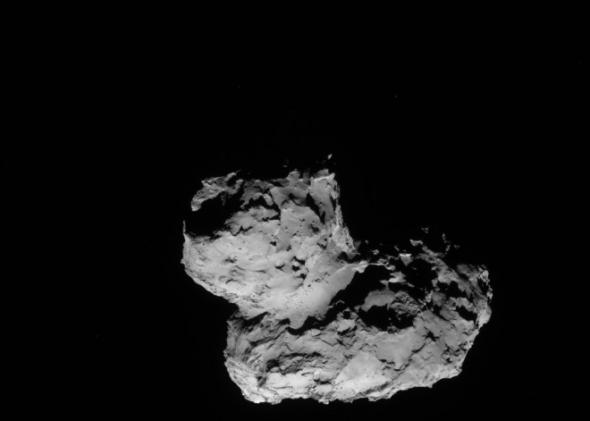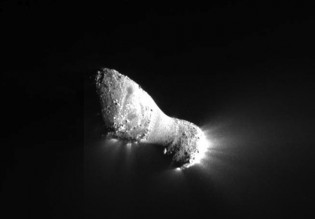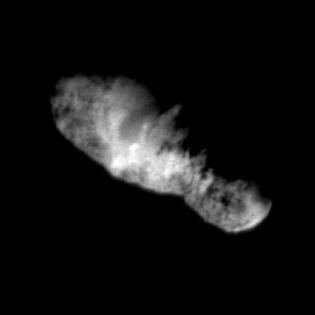Scientists Are Trying to Figure Out Why Rosetta’s Comet Is Shaped Like a Duck
Reprinted from 

ESA/Rosetta/NAVCAM
As scientists continue to pore over new images and data from the Rosetta mission to comet 67P/Churyumov-Gerasimenko, clues are emerging that may help answer a puzzling question: Why is this comet shaped like a duck?
The comet consists of two lobes, which, if you squint, look a bit like the head and body of a duck. The odd shape could have been formed by erosion from jets and bursts of gas shooting out from the comet, blowing off material to carve out the comet’s neck. Or, the head and body might have been two separate pieces that crashed into each other and stuck.
Now, an initial analysis based on new images from the Rosetta spacecraft orbiting comet 67P reveals fractures and layering features that seem to support the latter scenario, says Simone Marchi, a planetary scientist at the Southwest Research Institute in Boulder, Colorado. He presented the results on Dec. 18 in San Francisco, at the American Geophysical Union meeting.
Comet 67P’s double-lobed shape isn’t unusual. Both comet Borrelly, which was visited by Deep Space 1 in 2001, and comet Hartley 2, which was studied by NASA’s Deep Impact/EPOXI spacecraft in 2010, have two lobes. But scientists haven’t been able to determine for sure whether the comets were formed from erosion or a collision. Whichever the case, the process seems to be a general one that happens to many comets.

NASA/JPL-Caltech/UMD
Using new images taken with Rosetta’s OSIRIS camera, Marchi and his colleagues found terrace-like layers on the comet’s body. The layering aligns perfectly with parallel lines seen on the opposite side of the body, suggesting that these layers extend through the body as part of its internal structure. Although the head also has layers, they don’t align with those in the body, which implies that the two lobes were once two separate pieces. If the head and body were made from one piece, the layers should extend through both lobes in the same direction.
The neck of the comet also shows signs of a collision between the head and the body. The region is covered in big fractures, which would have been created by shockwaves that blasted through the comet during a crash. Some of the fractures are also misaligned, suggesting that they belonged to what were separate, smaller chunks that were floating around when the head merged with the body.
The general appearances of the head and neck are also somewhat different, according to the analysis. For example, there are more smooth patches that cover the body than the head.
A collision that could produce the comet would have needed to be a gentle one, or else the two pieces would’ve obliterated each other. The head and body could also have been part of a larger parent body that got blown apart during a different collision. After that initial impact, the head and body found themselves near each other, eventually pulled together by their mutual gravity.
So far, Marchi favors the parent-body scenario. The head shows a lot of fracturing, with gashes hundreds of feet long and possibly tens of feet deep. The fractures are too big to have formed from the gentle merger of the head and body, so Marchi thinks they may be indicative of a prior, more significant crash—perhaps the one that destroyed the hypothetical parent body.

NASA/JPL
A separate analysis presented at the AGU meeting on Dec. 18 using computer modeling is consistent with this scenario. Models show that early in the solar system’s history, there were plenty of icy objects flying around, and a small object could have slammed into a much larger body, splitting it into fragments. Comet 67P’s head and body could have been two of those fragments.
The two analyses complement each other, says Philippe Lamy, a planetary scientist at the Astrophysics Laboratory of Marseilles in France who led the second study. Still, it’s far from conclusive that the comet resulted from a collision. Lamy’s analysis also simulated comet orbits similar to comet 67P’s to see how much sunlight the comet would receive over time. Combining those simulations with a well-known model for how a comet erodes, the researchers found that most comets like 67P would easily be able to lose the amount of mass needed to produce 67P’s two lobes.
Sunlight is needed to trigger the jets of gas needed to blow off material and form the neck. So to actually carve out its duck shape, the comet would have had to change its orientation at some point in the past to allow direct sunlight to shine on what’s now the comet’s neck. As for how that might have happened, no one knows. But it’s certainly possible, says Lamy, who is a member of the OSIRIS team along with Marchi.
According to Lamy’s analysis, both erosion and collision—or a combination of the two—could have formed comet 67P. As the Rosetta mission continues in the coming months, Marchi says, better data and higher resolution pictures will hopefully point scientists closer to the true answer.
More from Wired:
Future Tense is a partnership of Slate, New America, and Arizona State University.
